|
 Baguale Baguale
|
|
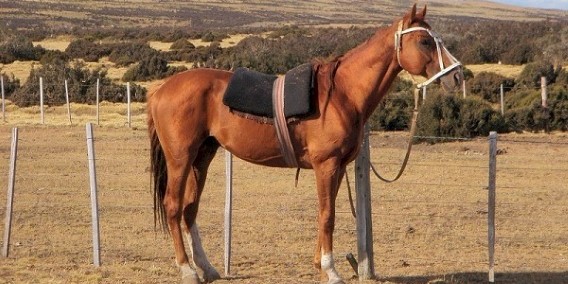 Baguales are wild horses that roam the vast Patagonian
grasslands and forests of Argentina and Chile. They are a sturdy and robust horse;
they can tolerate the highly variable climate of their native region.
Baguales are wild horses that roam the vast Patagonian
grasslands and forests of Argentina and Chile. They are a sturdy and robust horse;
they can tolerate the highly variable climate of their native region.
Most likely they evolved during the 16th century, with the
introduction of Andalusian horses in Argentina by the Spanish conquistadors. It
is believed that some of the horses either were released or had escaped,
forming feral herds, which wandered freely in the steppes and grasslands.
Today, a few hundred Baguales horses remain with in Torres
del Paine. However, the National Park authorities consider these horses as
invasive and have ordered for their removal. Several research teams and
non-profit organizations
...
|
 |
|
 Baguio Light Baguio Light
|
|
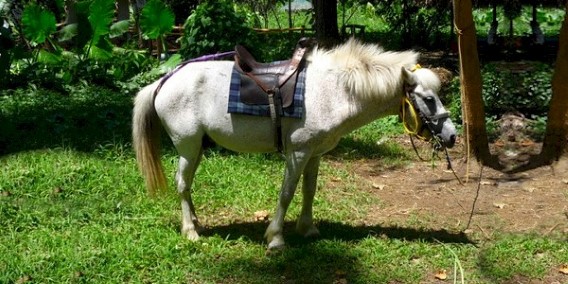 Baguio light horses and Baguio ponies are Philippine horses
known for their elegance, hardiness, and disease resistance ability.
Baguio light horses and Baguio ponies are Philippine horses
known for their elegance, hardiness, and disease resistance ability.
Baguio horses and ponies descended from breeding stock
brought by the Chinese, Brazilian, and other South American traders.
Subsequently, the dealers abandoned their animals when they left the Philippine
Islands. The small horses and ponies that evolved from these equine breeds
adapted to the native climate and became physically sound and tough.
During the early 1700s, these horses along with other equine
breeds flourished in the country. However, lack of selective breeding programs
caused their numbers to decline gradually. Arabian and Spanish bloods were
added to refine their t
...
|
 |
|
 Bahr-El-Ghazal Bahr-El-Ghazal
|
|
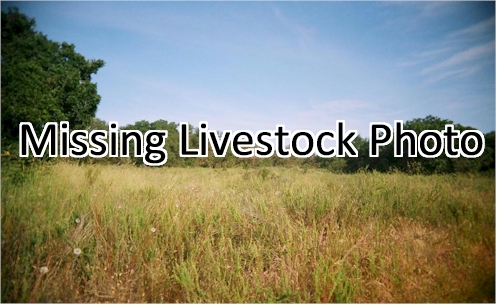 Bahr-El-Ghazal are a variety of Dongala horse from Chad in
the area of Kreda and Ganaston. They are slightly taller than Dongala horse.
They are a light horse with a reputation for poor quality. A lack of good management
and poor local conditions has both contributed to their lesser quality. There
are estimated to be around 10,000 Bahr-El-Ghazal horses left.
Bahr-El-Ghazal are a variety of Dongala horse from Chad in
the area of Kreda and Ganaston. They are slightly taller than Dongala horse.
They are a light horse with a reputation for poor quality. A lack of good management
and poor local conditions has both contributed to their lesser quality. There
are estimated to be around 10,000 Bahr-El-Ghazal horses left.
|
 |
|
 Baikal Baikal
|
|
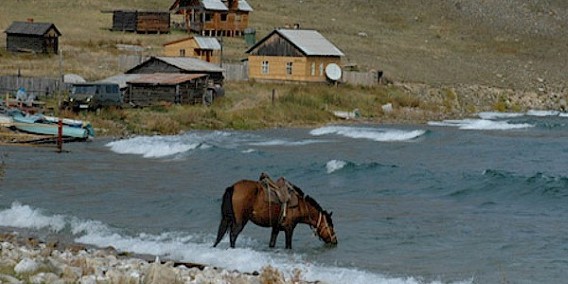 Hailing from the majestic Lake Baikal region bordering Mongolia, the Baikal horse isn''t merely a breed; it''s a type woven into the very fabric of the area''s history. For generations, these hardy, small horses have served as indispensable companions, fulfilling diverse needs from light work and transportation to, more recently, even offering tourists unique horseback adventures through breathtaking landscapes.
Hailing from the majestic Lake Baikal region bordering Mongolia, the Baikal horse isn''t merely a breed; it''s a type woven into the very fabric of the area''s history. For generations, these hardy, small horses have served as indispensable companions, fulfilling diverse needs from light work and transportation to, more recently, even offering tourists unique horseback adventures through breathtaking landscapes.
Their resilient nature shines through their ability to navigate rough terrain and withstand harsh weather. Whether carrying essential supplies or offering visitors a glimpse into the region''s beauty, the Baikal horse remains a vital part of the local culture, its history as long and enduring as the vast lake it calls hom
...
|
 |
|
 Baise Baise
|
|
 Baise horses (also known as the Guangxi) are a pony-sized
horse native to the Guangxi region of China, where the climate is mild and
horse breeding has long been common practice. Like other Asian breeds (the
Mongolian horse in particular), they thrive at high altitudes and roams freely
when not working.
Baise horses (also known as the Guangxi) are a pony-sized
horse native to the Guangxi region of China, where the climate is mild and
horse breeding has long been common practice. Like other Asian breeds (the
Mongolian horse in particular), they thrive at high altitudes and roams freely
when not working.
They have obvious physical ties with Mongolian animals. Guangxi''s
mild climate has long favored horse breeding. Bronze statues from 206 to 25
B.C. have been found that look almost exactly like this animal in confirmation.
Baise horses are an average height of 11 to 11.2 hands (44
to 46 inches, 112 to 117 cm). They are smaller than other breeds in northern
and western China. Their head is heavy, with
...
|
 |
|
 Baixadeiro Baixadeiro
|
|
 Baixadeiro are a small horse from the marshlands of Brazil. They are an extremely old breed that looks
somewhat like the Pantaneiro Horse of the area, but they are much smaller. They
are dismally under-developed, perhaps because they inhabit lands that are
virtually wetlands most of the year.
Baixadeiro are a small horse from the marshlands of Brazil. They are an extremely old breed that looks
somewhat like the Pantaneiro Horse of the area, but they are much smaller. They
are dismally under-developed, perhaps because they inhabit lands that are
virtually wetlands most of the year.
Today, they are almost extinct but formal breeding programs
have been set up to continue the lines as these animals have been used in the
area for centuries.
|
 |
|
 Bakhtiari Bakhtiari
|
|
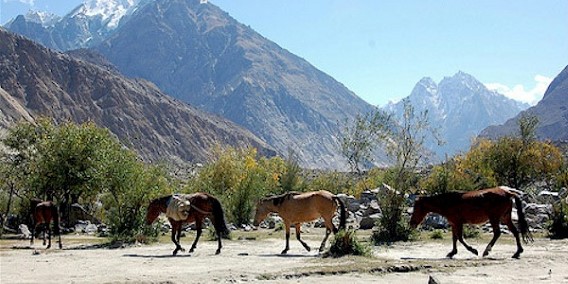 Bakhtiari horses are native to Pakistan and have distinctive
turned in ears (similar to those of the Marwari horse). They are believed to be
related to Barb horses and are known for their strength, endurance, and fine
confirmation.
Bakhtiari horses are native to Pakistan and have distinctive
turned in ears (similar to those of the Marwari horse). They are believed to be
related to Barb horses and are known for their strength, endurance, and fine
confirmation.
Today their bloodlines have been diluted to the point there
are very few of pure lineage, making this an incredibly rare breed.
They are on average height 14 hands tall, have a medium
sized fine head with a straight or slightly convex profile. Their eyes are
large and expressive. Their neck is long and muscular. Their back is short and
strong. Their legs are fine and strong with good joints and defined tendons.
And their feet are very hard and strong.
They are fo
...
|
 |
|
 Baladi Baladi
|
|
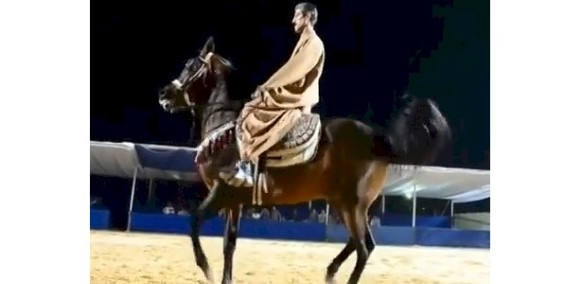 Baladi (also known as Egyptian Horses) are an Egyptian
horse of questionable bloodlines. They are no longer considered an individual
breed as they once were. There has been significant “Arabization” of the
indigenous horses of Egypt, due to the short distance between Arabia and the
Nile. The resulting horses come from combinations of Arabian bloodlines and are
unable to be registered. Plus an influx of English Thoroughbred blood was added
for increased speed and size, but because of their lack of papers these animals
are shunned by breeders and tribesmen. Although they are still magnificent horses
and often faster over short distances, (but not as hardy over distance as the
pureblood Arabian).
Baladi (also known as Egyptian Horses) are an Egyptian
horse of questionable bloodlines. They are no longer considered an individual
breed as they once were. There has been significant “Arabization” of the
indigenous horses of Egypt, due to the short distance between Arabia and the
Nile. The resulting horses come from combinations of Arabian bloodlines and are
unable to be registered. Plus an influx of English Thoroughbred blood was added
for increased speed and size, but because of their lack of papers these animals
are shunned by breeders and tribesmen. Although they are still magnificent horses
and often faster over short distances, (but not as hardy over distance as the
pureblood Arabian).
|
 |
|
 Bali Bali
|
|
 Bali Ponies are an ancient breed now living on the
Indonesian island of Bali. Its roots are unknown, although one theory is that
ponies of ancient stock were brought to Indonesia by the Chinese in the 6th
century. If this theory is true, the Bali pony would owe much of its roots to
the Mongolian Horse. In addition to the Mongolian horse, it is known that some
Indian stock were taken to Indonesia (although it is unknown exactly which
breeds), and the Dutch also brought various eastern breeds to the country
during the 18th century. Therefore, the Bali pony likely has been influenced by
both the Mongolian horse, and various other eastern breeds.
Bali Ponies are an ancient breed now living on the
Indonesian island of Bali. Its roots are unknown, although one theory is that
ponies of ancient stock were brought to Indonesia by the Chinese in the 6th
century. If this theory is true, the Bali pony would owe much of its roots to
the Mongolian Horse. In addition to the Mongolian horse, it is known that some
Indian stock were taken to Indonesia (although it is unknown exactly which
breeds), and the Dutch also brought various eastern breeds to the country
during the 18th century. Therefore, the Bali pony likely has been influenced by
both the Mongolian horse, and various other eastern breeds.
The Bali Ponies are quite hardy and self-sufficient,
surviving with l
...
|
 |
|
 Balikun Balikun
|
|
 Balikun horses are a rare light draft breed from the
Xinjiang region in northwest China. They are well adapted for harsh environment
and used mainly for transportation. They are able to survive on steppe hills
and and pasture with harsh temperatures as low as 40 degrees below zero.
Balikun horses are a rare light draft breed from the
Xinjiang region in northwest China. They are well adapted for harsh environment
and used mainly for transportation. They are able to survive on steppe hills
and and pasture with harsh temperatures as low as 40 degrees below zero.
Balikun horses developed from Kazakh and Mongolian horses;
however, over 200 years of selective breeding has made the Balikun horse a
breed of its own.
Balikun horses stand, on average, from 12.2 to 13.1 hands.
They have heavy heads with short, thick, muscular necks. Their withers are
often rather low, and the backs are short, flat, and very strong. Their
shoulders are straight, but muscular. Their croup is sloped, with their tail
being l
...
|
 |
|
 Baluchi Baluchi
|
|
 Baluchi (also known as Beledougou, or Banamba) horses are
native to the Baluchistan, Sindh and Punjab Provinces in Pakistan. However,
they are most likely related to the West African Barb horses of Mali, Africa.
They share the same ancestors as the Waziri, which is a smaller horse breed
known for their strength, good structure, and stamina.
Baluchi (also known as Beledougou, or Banamba) horses are
native to the Baluchistan, Sindh and Punjab Provinces in Pakistan. However,
they are most likely related to the West African Barb horses of Mali, Africa.
They share the same ancestors as the Waziri, which is a smaller horse breed
known for their strength, good structure, and stamina.
Baluchi horses are on average about 14 hands high. They have
a medium-sized fine head, straight or slightly curved profile, large eyes,
tulip ears that turn inward and touch, a long muscular neck, pronounced
withers, a short strong back, and fine strong legs with good joints and defined
tendons. There are found in bay, chestnut, or gray.
Baluchi
horses are known
...
|
 |
|
 Ban'ei Ban'ei
|
|
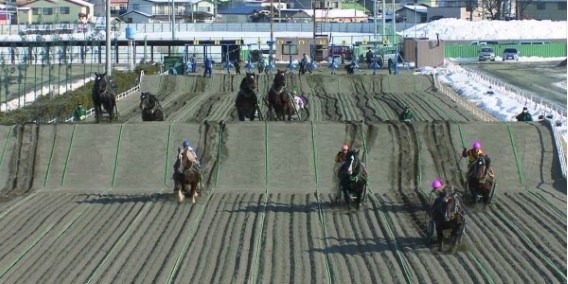 Ban''ei horses are from Hokkaido, Japan, where they are used
for unique draft races, called the Ban-ei Keiba races, in which the horse pulls
a heavy sledge (called a Sori). These races, which are only conducted at four
racecourses in Hokkaido, are run by such heavy horses bred from stock such as
the sturdy Percherons, Bretons and Belgians, which pull a steel sleigh carrying
a heavy load, together weighing from about half a ton to one ton (including
jockey, sledge, and harness), along a 200-meter separated straight track with
two humps.
Ban''ei horses are from Hokkaido, Japan, where they are used
for unique draft races, called the Ban-ei Keiba races, in which the horse pulls
a heavy sledge (called a Sori). These races, which are only conducted at four
racecourses in Hokkaido, are run by such heavy horses bred from stock such as
the sturdy Percherons, Bretons and Belgians, which pull a steel sleigh carrying
a heavy load, together weighing from about half a ton to one ton (including
jockey, sledge, and harness), along a 200-meter separated straight track with
two humps.
The dynamic Ban-ei Keiba races, which enjoy a large
following, originated as a competition among farmers and locals at least 55
years ago at festivals in the areas in Hokkaido and Tohoku.
...
|
 |
|
 Banat Banat
|
|
 Banat horses were a moderately large-framed horse from the
Timus Plateau of Romania; however, they are now extinct.
Banat horses were a moderately large-framed horse from the
Timus Plateau of Romania; however, they are now extinct.
They were developed by crossing Nonius, Noric, Ardennes,
Oldenburg, and Lipitsa horses. They became an important animal to the local
people and were used primarily for agricultural work.
Unfortunately, with the emergence of modernization
techniques for farming, the Banat, among other draft type animals fell into
extinction.
|
 |
|
 Bandiagara Bandiagara
|
|
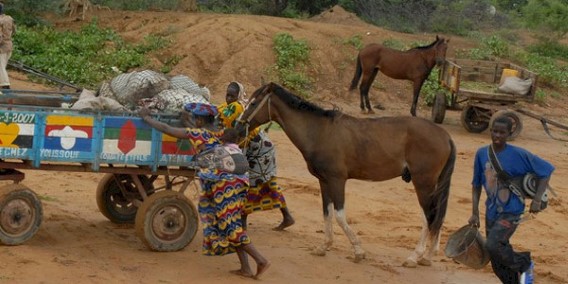 Bandiagara horses are a mid-sized, docile horse breed from Mali and Niger in Africa. They are a Barb type with fragile and lovely facial features. For the most part, this they are suited to the climatic harshness of the area.
Bandiagara horses are a mid-sized, docile horse breed from Mali and Niger in Africa. They are a Barb type with fragile and lovely facial features. For the most part, this they are suited to the climatic harshness of the area.
On average they stand between 14.3 to 15 hands high. Their neck is short and thick with an ample chest and shoulder. Their back is long with rounded croup. Their tail is low set. Their legs are think and sinewy. And their hooves are hard and small.
|
 |
|
 Banker Banker
|
|
 Banker horses are descendants from domesticated Spanish
horses that were brought to America in 16th century by explorers and abandoned
on the Outer Banks of North Carolina which is where their name
"Banker" was derived. Banker horses were originally domesticated;
however, since they were abandoned and left to fend for themselves, they''ve
become feral.
Banker horses are descendants from domesticated Spanish
horses that were brought to America in 16th century by explorers and abandoned
on the Outer Banks of North Carolina which is where their name
"Banker" was derived. Banker horses were originally domesticated;
however, since they were abandoned and left to fend for themselves, they''ve
become feral.
Banker horses can be found on the Outer Banks barrier
islands of North Carolina''s coast. They reside on Corolla Island, Currituck
Banks, Ocracoke Island, Shackleford Banks, and in the Rachel Carson Estuarine
Sanctuary. They feed on bulrushes, sea oats, poison ivy, and Saltmarsh
Cord grass. Because of their poor diet, the horses on the Outer Banks are
smaller than domest
...
|
 |
|
 Barb Barb
|
|
 Barb horses are a light riding horses from the Maghreb
region of northern Africa. There are several varieties of barb horses including
Algerian, Moroccan, and Tunisian. They are also the foundation breed of the
West African Barb and the Spanish Barb which was developed in the United
States.
Barb horses are a light riding horses from the Maghreb
region of northern Africa. There are several varieties of barb horses including
Algerian, Moroccan, and Tunisian. They are also the foundation breed of the
West African Barb and the Spanish Barb which was developed in the United
States.
|
 |
|
 Bardigiano Bardigiano
|
|
 Bardigiano horses, also known as Bardigiano Ponies, are from
Bardi, Italy.
Bardigiano horses, also known as Bardigiano Ponies, are from
Bardi, Italy.
The first horses that populated Bardi were brought during the
Roman Era. During the centuries, the breed developed as a mountain horse; in the
15th century, there were attempts to make it more gentle by cross-breeding it with
Arabian-Friulian horses, thus obtaining a horse very similar to the one of today.
They almost became extinct after the First World War. In 1977,
a "Regulation for the selection and for the Genealogic Book of the Bardigiano
horse" was approved. This sets the breed standard and had the aim of making
it homogenous.
Bardigiano horses were used in the past for agricultural work
in impervious areas and even m
...
|
 |
|
 Basuto Pony Basuto Pony
|
|
 Basuto Ponies are from South Africa. They are derived from
horses imported by Dutch settlers in 17th century.
Basuto Ponies are from South Africa. They are derived from
horses imported by Dutch settlers in 17th century.
Basuto Ponies arrived in South Africa in 1653, when four
horses were introduced to the Cape area by the Dutch East India Trading
Company. The exact breed of these horses is unknown, but they may have been
Arabian, Persian, or similar to the Java Pony. They were upgraded later with
Arabian and Persian blood.
These original imported horses became the founders of the
Cape Horse, which became extremely popular and especially gained an admirable
reputation during the Boer Wars. The Cape Horse and the Basuto probably were
originally the same horse, and then with continual Thoroughbred and Arabian
blood
...
|
 |
|
 Batak Pony Batak Pony
|
|
 Batak Ponies are from Indonesia originating in Central
Sumatra. They are thought to have descended from Mongolian and Arabian horses,
and have continually been infused with additional Arabian blood to improve their
quality. They are selectively breed by the Indonesians, and are often used to
upgrade the quality of horses and ponies on nearby islands. The Batak Pony was
once used as a sacrificial animal in religious ceremony.
Batak Ponies are from Indonesia originating in Central
Sumatra. They are thought to have descended from Mongolian and Arabian horses,
and have continually been infused with additional Arabian blood to improve their
quality. They are selectively breed by the Indonesians, and are often used to
upgrade the quality of horses and ponies on nearby islands. The Batak Pony was
once used as a sacrificial animal in religious ceremony.
They are slender, but still strong and sturdy. They are
generally well-conformed. Poor forage is a major contributor to conformation
abnormalities. The only other breed of the country which is of better quality
is the Sandalwood Pony. The ponies have a fine head with a straight or slightly
conve
...
|
 |
|
 Bavarian Warmblood Bavarian Warmblood
|
|
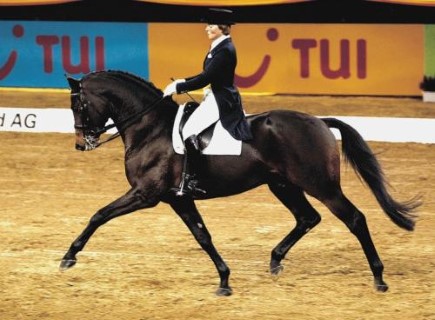 Bavarian Warmblood (also known as Bayerisches
Warmblut) horses are from southern Germany. They were developed from an
older Bavarian heavy warmblood breed called the Rottaler. Since mechanization
in the mid-20th century, the Bavarian Regional Horse Breeders'' Society has
concentrated on producing a riding horse for the Olympic disciplines and recreational
riding based on other European warmblood bloodlines.
Bavarian Warmblood (also known as Bayerisches
Warmblut) horses are from southern Germany. They were developed from an
older Bavarian heavy warmblood breed called the Rottaler. Since mechanization
in the mid-20th century, the Bavarian Regional Horse Breeders'' Society has
concentrated on producing a riding horse for the Olympic disciplines and recreational
riding based on other European warmblood bloodlines.
The easiest way to recognize a Bavarian Warmblood is by the
brand on the left thigh, which is a crowned shield outside the letter
"B". All colors are permitted, though dark, solid colors are
preferred. The ideal height is between 158 and 170 cm tall at the withers
(15.2-16.2 hands).
Bavarian Warmblood
...
|
 |
|
 Belgian Warmblood Belgian Warmblood
|
|
 Belgian Warmbloods are bred distinctively as a show horse
that excels in dressage and jumping arenas. They are basically the mixture of
many breeds with the lighter Belgian agricultural horses as their base. In the
1950s these agricultural horses were mixed with Gelderlanders for greater size
and strength. In the 1960s Selle Francais and Hanoverian were introduced. They
gave the Belgian Warmblood greater athletic ability and freedom of movement.
The Thoroughbred and Anglo-Arabian horses introduced to the breed conformation
and speed.
Belgian Warmbloods are bred distinctively as a show horse
that excels in dressage and jumping arenas. They are basically the mixture of
many breeds with the lighter Belgian agricultural horses as their base. In the
1950s these agricultural horses were mixed with Gelderlanders for greater size
and strength. In the 1960s Selle Francais and Hanoverian were introduced. They
gave the Belgian Warmblood greater athletic ability and freedom of movement.
The Thoroughbred and Anglo-Arabian horses introduced to the breed conformation
and speed.
They stand around 16.2 hands high. Their head is alert and
full of quality, mainly due to its Anglo-Arabian influence. Their withers are
well placed and their shoulders are of good ridi
...
|
 |
|
 Bhirum Bhirum
|
|
 Bhirum Ponies (also known as Nigerian Ponies) are a dwarf
horse from the northern regions of Nigeria. They are thought to be a descendant
of the little known Poney Mousseye of Cameroon. They are also thought to come
from Barb horses which were brought to Nigeria by Nomads. These animals were
bred to local ponies and the resulting animal became the Bhirum Pony.
Bhirum Ponies (also known as Nigerian Ponies) are a dwarf
horse from the northern regions of Nigeria. They are thought to be a descendant
of the little known Poney Mousseye of Cameroon. They are also thought to come
from Barb horses which were brought to Nigeria by Nomads. These animals were
bred to local ponies and the resulting animal became the Bhirum Pony.
They are a large pony breed, although they are occasionally
referred to as small horses. They are incredibly versatile and can resist the
heat of their environment.
|
 |
|
 Bhotia Bhotia
|
|
 Bhotia Ponies are bred and raised in various regions of
India such as Darjeeling, Sikkim, Bhutan, and Nepal. They are used as a pack
animal and for riding.
Bhotia Ponies are bred and raised in various regions of
India such as Darjeeling, Sikkim, Bhutan, and Nepal. They are used as a pack
animal and for riding.
Their head usually has a pronounced jaw line, straight
profile, small ears and eyes. Their neck is a muscular and a bit short, their
chest is deep, their shoulder is straight. Their ponies have powerful
hindquarters, and short, strong legs with good joints. They stand at 12.2 hh,
they are usually bay or gray, but may be any solid color. They tend to be
narrow in build.
|
 |
|
 Black Forest Black Forest
|
|
 Black Forest, also known as Schwarzwalder Kaltblut, Horses
come from the Black forest, Germany. They were well known as the pearl of The
Black Forest back in their day and have derived from the cold bloods that were
residing in the region during the Middle Ages. They came about as a result of
breeding a Haflinger and a Noriker. Later on, the breed would be closer
introduced to the Brabant breed in a poor attempt at making them taller, which
was not successful whatsoever. Once the twentieth century arrived, some were
enabled to breed with any stallion they wanted to. Currently, there are fifty
state approved stallions in the area and over seven hundred registered mares
alike. They have a great reputation in local areas and are consi
...
Black Forest, also known as Schwarzwalder Kaltblut, Horses
come from the Black forest, Germany. They were well known as the pearl of The
Black Forest back in their day and have derived from the cold bloods that were
residing in the region during the Middle Ages. They came about as a result of
breeding a Haflinger and a Noriker. Later on, the breed would be closer
introduced to the Brabant breed in a poor attempt at making them taller, which
was not successful whatsoever. Once the twentieth century arrived, some were
enabled to breed with any stallion they wanted to. Currently, there are fifty
state approved stallions in the area and over seven hundred registered mares
alike. They have a great reputation in local areas and are consi
...
|
 |
|
 Blazer Blazer
|
|
 Blazer Horses were developed in the 1950s and 1960s in
northwestern United States. They can trace their ancestry to one chestnut
stallion named Little Blaze, who was foaled in 1959. Little Blaze was bred and
owned by F. Neil Hinck, an American horse trainer from Bedford, Wyoming. The
descendant of Mormon pioneers and Danish horsemen, Hinck came from a ranch
family and had extensive experience with most breeds of the day. Little Blaze
was combinationof American Quarter Horse and Morgan Horse with some Shetland
Pony and Thoroughbred.
Blazer Horses were developed in the 1950s and 1960s in
northwestern United States. They can trace their ancestry to one chestnut
stallion named Little Blaze, who was foaled in 1959. Little Blaze was bred and
owned by F. Neil Hinck, an American horse trainer from Bedford, Wyoming. The
descendant of Mormon pioneers and Danish horsemen, Hinck came from a ranch
family and had extensive experience with most breeds of the day. Little Blaze
was combinationof American Quarter Horse and Morgan Horse with some Shetland
Pony and Thoroughbred.
Blazers are known for being versatile at any sport
competition and having gentle and intelligent dispositions. Blazer horses do
not exceed 15 hands (60 inches, 152 cm) at full maturity, a
...
|
 |
|
 Boerperd Boerperd
|
|
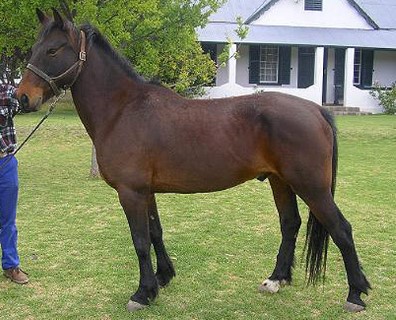 Boerperd, or Boer Ponies, are a tough horse that can still
remain their cool and be kind enough to allow for kids to ride, they are hardy,
enduring, and have been used for harness work, endurance, and for riding people
of all ages and sizes. They are found in Johannesburg, Swaz, Lesotho, and Cape
Town, South Africa.
Boerperd, or Boer Ponies, are a tough horse that can still
remain their cool and be kind enough to allow for kids to ride, they are hardy,
enduring, and have been used for harness work, endurance, and for riding people
of all ages and sizes. They are found in Johannesburg, Swaz, Lesotho, and Cape
Town, South Africa.
Boerperd’s stand at around fifteen hands in full grown size.
They are generally bred in any color, typically one solid color rather than
mixtures or patterns. They are a fit and lean breed with good shoulders and
hard feet, they also have great joints and a shorter back, which aids their
strength and ability to carry passengers for hours on end without struggling.
Boerperd’s are very
...
|
 |
|
 Bose Bose
|
|
 Bose Ponies are from the Bose and HechirnPrefecture-Guangxizhuang region of China. They are best known for performingrngeneral riding and work.
Bose Ponies are from the Bose and HechirnPrefecture-Guangxizhuang region of China. They are best known for performingrngeneral riding and work.
Bose Ponies are bay colored. They are on average 11.1 torn11.2 hands tall. Their head is dry, straight, and slightly weighty. Their profilernis concave and their jaw is wide. Their ears are small and alert. Their neck isrnmoderately long and their withers are moderate. They have a short back andrntheir croup is rounded. They have a bushy, but thin, mane and tail. Their legsrnare short and strong with good joints. Their hooves are firm.
|
 |
|
 Bosnian Bosnian
|
|
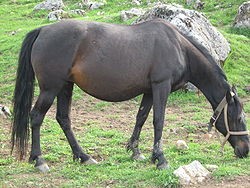 Bosnian Ponies, found in Bosnia and Herzegovina, are a
member of the group of horses known as the Balkan breeds, and are thought to be
descended from a cross between the Tarpan and Asian Wild Horses.
Bosnian Ponies, found in Bosnia and Herzegovina, are a
member of the group of horses known as the Balkan breeds, and are thought to be
descended from a cross between the Tarpan and Asian Wild Horses.
Beginning in the 1900s, they have been selectively bred
through a government-controlled breeding programs. The principle breeding
center for many years was the Borike Stud in Bosnia. The state controlled all
breeding stallions, while mares were privately owned. During the 1940s three
stallions, Agan, Barat, and Misco, were used to improve the breed. Agan and
Barat resembled the Asian Wild Horse type, while Misco was a lighter type.
Until the Bosnian War, there were strict standards,
including performance
...
|
 |
|
 Boulonnais Boulonnais
|
|
 Boulonnais horses come from France. They are legendary
creatures that were brought from France by Julius Caesar during his preparation
to invade Britain. They were once known for roaming many lands such as Calais,
Belgium, Eterpigny, and along the English Channel in the United Kingdom. Most
of the heavier draft breeds were bred in the Northwestern areas of France.
Boulonnais horses come from France. They are legendary
creatures that were brought from France by Julius Caesar during his preparation
to invade Britain. They were once known for roaming many lands such as Calais,
Belgium, Eterpigny, and along the English Channel in the United Kingdom. Most
of the heavier draft breeds were bred in the Northwestern areas of France.
They are often referred to as the Thoroughbred of the draft
breeds. This was as a result of their elegance that they received from the
bloodlines of some Arab and Iberian horses. While they are recognized as being
derived from the seventeenth century, some feel there were in fact two various
styles of the breed. One was noted as the heavier draft version and th
...
|
 |
|
 Brabant Brabant
|
|
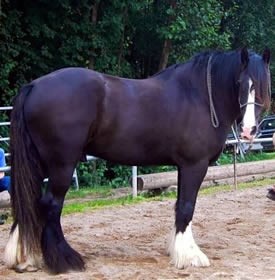 Brabant horses are from Belgium, and can be found all over
Germany as well as the Netherlands, France, and more specifically set inside
Brussels. They are used for harness work and for shows or competitions alike.
Their unique appearances make it easier for them to do very well inside the
competitive circuit and they have a very friendly personality to boot.
Brabant horses are from Belgium, and can be found all over
Germany as well as the Netherlands, France, and more specifically set inside
Brussels. They are used for harness work and for shows or competitions alike.
Their unique appearances make it easier for them to do very well inside the
competitive circuit and they have a very friendly personality to boot.
Brabant horses have quite a history coming from significant
dignitaries using them on a regular basis for being bred for use in shows. It
has been noted that the Brabant horses were used to carry those involved in the
Norman Conquest of Britain during 1066. They are a very large horse variation
that was reliable and dependably used on missions and in the military
...
|
 |
|
 Brandenburgers Brandenburgers
|
|
 Brandenburgers are a well-balanced horse with a lively
temperament, an easy to get along with character and little tendency to
nervousness.
Brandenburgers are a well-balanced horse with a lively
temperament, an easy to get along with character and little tendency to
nervousness.
Horse breeding was first mentioned in documents in the
Brandenburg March in the 15th century although at that point, there was not a
uniform or standardized breed. The development of the modern Brandenburger
sport horse during the mid-20th century was achieved by utilizing Trakehners,
Hanoveranians, and English Thoroughbreds. The national and state stud of
Neustadt/Dosse, which was founded by King Frederick Wilhelm II in 1788, had
substantial influence on the development of the Brandenburger.
Following reunification with the former German Democratic
Republic (East Ge
...
|
 |
|
 Brazilian Sport Brazilian Sport
|
|
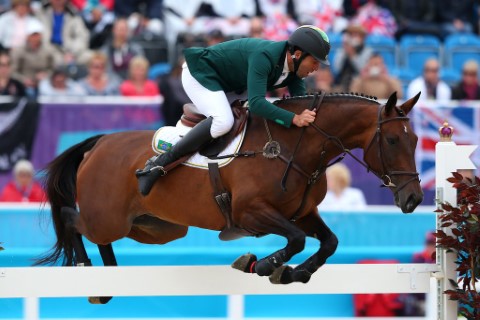 Brazilian Sport Horses (Brasileiro de Hipismo), were
developed specifically for competition in 1970. They were developed from
Andalusian, Thoroughbred, Trakehner, Hanoverian, Holsteiner, Oldenburger,
Westphalian, Irish Hunter, Selle Francais, Argentine-Anglo and Belgian
Warmblood horses. They are popular in the US and Europe and have successfully
completed recent Olympic Games. In 1996 four Brazilian Sport Horses, Aspen,
Adelfos, Cassiano Joter, and Calei Joter, competed in the Atlanta Olympics and
in Syndey in 2000.
Brazilian Sport Horses (Brasileiro de Hipismo), were
developed specifically for competition in 1970. They were developed from
Andalusian, Thoroughbred, Trakehner, Hanoverian, Holsteiner, Oldenburger,
Westphalian, Irish Hunter, Selle Francais, Argentine-Anglo and Belgian
Warmblood horses. They are popular in the US and Europe and have successfully
completed recent Olympic Games. In 1996 four Brazilian Sport Horses, Aspen,
Adelfos, Cassiano Joter, and Calei Joter, competed in the Atlanta Olympics and
in Syndey in 2000.
They are intelligent, light, agile, quick, athletic and
large (over 16 hands high), and lively. They have a sweet disposition, solid
work ethic, endless ability, calm, brave and balanced. They hav
...
|
 |
|
 Breton Breton
|
|
 Breton horses come from France but can be seen along the
British side of the English Channel and most often in the land of Rennes.
Primarily they are raised for light or heavy drafting. They are sweet, easy to
maintain, and full of energy. They can be extremely handy on farmlands and are
very loyal to their owners as well.
Breton horses come from France but can be seen along the
British side of the English Channel and most often in the land of Rennes.
Primarily they are raised for light or heavy drafting. They are sweet, easy to
maintain, and full of energy. They can be extremely handy on farmlands and are
very loyal to their owners as well.
They were one of the first types of horses considered to be
mountain animals. In the Middle Ages they were bred into two various breeds.
One was considered a heavier style noted as the Sommier, and the other was the
Rossier, which was a lighter horse style created just for the primary use of
riding. During the nineteen hundreds, the breeders began to make ones that were
bigger, stronger, and
...
|
 |
|
 British Spotted Pony British Spotted Pony
|
|
 British Spotted Ponies have been known to exist since prehistoric
times - they appear in cave paintings in France dating back around 20,000 years
and have also featured in Egyptian pictures dating from 1400 BC. They were at
one time feral in the British Isles and their spotted coat pattern was their
natural camouflage as they roamed the heaths and forests of ancient Britain.
British Spotted Ponies have been known to exist since prehistoric
times - they appear in cave paintings in France dating back around 20,000 years
and have also featured in Egyptian pictures dating from 1400 BC. They were at
one time feral in the British Isles and their spotted coat pattern was their
natural camouflage as they roamed the heaths and forests of ancient Britain.
Through history Spotted Ponies have been regarded as
somewhat magical and mystical and were subsequently highly regarded by Royalty
and noblemen. During Roman times, some of the mounts of the more important
Officers were spotted horses of great elegance; and during the dark ages many
spotted Ponies were sent as gifts between the Royal Families o
...
|
 |
|
 Brumbie Brumbie
|
|
 Brumbies are free-roaming feral horses in Australia.
Although they are found in many areas around the country, the best-known
Brumbies are found in the Australian Alps region. Brumbies have been seen in
the Man from Snowy River movies and the opening of the 2000 Sydney Olympic
Games.
Brumbies are free-roaming feral horses in Australia.
Although they are found in many areas around the country, the best-known
Brumbies are found in the Australian Alps region. Brumbies have been seen in
the Man from Snowy River movies and the opening of the 2000 Sydney Olympic
Games.
Brumbies are the descendants of the horses that were
transported on ships from England with convicts and first settlers. The initial
horses included "Capers" from South Africa, Timor Ponies from
Indonesia, British pony and draught horse breeds, and a significant number of
Thoroughbreds and Arabians. Many of those early horses escaped or were left to
run free. Over time the developed into their own breed, much like America
Mustang
...
|
 |
|
 Brumby Brumby
|
|
 The sun-drenched plains and rugged mountains of Australia echo with the thunder of hooves - not from domesticated steeds, but from the Brumby, a legend born not in stables but in the untamed spirit of escaped horses centuries ago. These hardy creatures, a tapestry woven from diverse European breeds brought to Australia, embody freedom, resilience, and the wildness they call home.
The sun-drenched plains and rugged mountains of Australia echo with the thunder of hooves - not from domesticated steeds, but from the Brumby, a legend born not in stables but in the untamed spirit of escaped horses centuries ago. These hardy creatures, a tapestry woven from diverse European breeds brought to Australia, embody freedom, resilience, and the wildness they call home.
Medium-built with strong bones and surefooted hooves, they''re perfectly adapted to their surroundings. Coats in shades of chestnut, bay, or even dappled gray blend seamlessly, offering camouflage and protection. Short backs and powerful hindquarters enable them to navigate rough terrain with agility, while their spirited nature and keen intelligence shi
...
|
 |
|
 Buckskin Buckskin
|
|
 Buckskin Horses are not a specific breed, they are horses
that have a common color - tan or bronze coloring with black points. A true
Buckskin should be the color of tanned deer hide with black points. Shades may
vary from yellow to dark gold. Points (mane, tail, and legs) can be dark brown,
or black. Ponies and horses showing predominance of draft horse blood are not
eligible.
Buckskin Horses are not a specific breed, they are horses
that have a common color - tan or bronze coloring with black points. A true
Buckskin should be the color of tanned deer hide with black points. Shades may
vary from yellow to dark gold. Points (mane, tail, and legs) can be dark brown,
or black. Ponies and horses showing predominance of draft horse blood are not
eligible.
Buckskins developed a strong reputation as a sturdy working
horse in the frontier of the western United States. They were highly regarded
by the cowboys of the old west, Buckskins were used for pack, harness, and
saddle.
The American Buckskin Registry Association was founded in
1962, it opened its registry to not only the Bucksk
...
|
 |
|
 Bucovina Bucovina
|
|
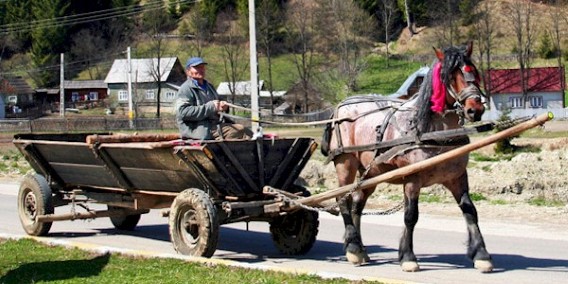 Bucovina horses are an extremely rare cross between Romanian
Hutzel (Huzel) horses with an infusion of draught horse blood. They are suitable for riding, draught work,
and logging. They retain the toughness, economy, and tractability of Hutzel
horses.
Bucovina horses are an extremely rare cross between Romanian
Hutzel (Huzel) horses with an infusion of draught horse blood. They are suitable for riding, draught work,
and logging. They retain the toughness, economy, and tractability of Hutzel
horses.
Their cost is roan coat color which most like comes from
Ardennes ancestr. Which is not a surprise since Ardennes were introduced into
Romania after the Second World War to regenerate local stock.
|
 |
|
 Budyonny Budyonny
|
|
 Budyonny horses originated in Russia and are known for
having a iridescent coat. They received their name from Marshall Budyonny of
the red army. They can be found all over the Russian Federation; inside
Ukraine, Belarus, Moscow, Rostov, and along the Lake Ladoga.
Budyonny horses originated in Russia and are known for
having a iridescent coat. They received their name from Marshall Budyonny of
the red army. They can be found all over the Russian Federation; inside
Ukraine, Belarus, Moscow, Rostov, and along the Lake Ladoga.
Budyonny horses were created by combining the Thoroughbred
Don horses. They were utilized for all sorts of purposes as both work horses
and for leisure uses as well. They are an incredible cavalry horse; built for
speed and durability.
They are the perfect combination of strength with an
attractive appearance. They are noted by experts as being rather athletic and
coordinated and also mild tempered.
Budyonny horses have a g
...
|
 |
|
 Buohai Buohai
|
|
 Buohai horses are native to the Northeastern part of the
Shandong Province, China, near the Buohai Sea and the Yellow River. They have
been found in that area for at least 2700 years, but are originally from Mongolia.
Buohai horses are native to the Northeastern part of the
Shandong Province, China, near the Buohai Sea and the Yellow River. They have
been found in that area for at least 2700 years, but are originally from Mongolia.
In 1962 the Chinese government established a cross-breeding
program designed to improve the local stock. Attempts with riding horses were
unsuccessful and created animals too light for heavy agricultural work. Later
Ardennes and Soviet Heavy Draft blood was introduced and the resulting animals
was classified as the Buohai breed in China.
In 1974 a breed association was formed and the first animals
were registered as pureblood under the Buohai name. There is lot of variety in type due to
...
|
 |
|
 Burguete Burguete
|
|
 Burguete horses (also known as Caballo Burguete, Caballo de
Raza Burguete, or Aurizko Zaldia) are from the Navarre region of northern
Spain. They are listed in the Catálogo Oficial de Razas de Ganado de Espana in
the group of autochthonous breeds in danger of extinction. Their name is
derived from the town of Auritz/Burguete.
Burguete horses (also known as Caballo Burguete, Caballo de
Raza Burguete, or Aurizko Zaldia) are from the Navarre region of northern
Spain. They are listed in the Catálogo Oficial de Razas de Ganado de Espana in
the group of autochthonous breeds in danger of extinction. Their name is
derived from the town of Auritz/Burguete.
|
 |
|
 Burmese Pony Burmese Pony
|
|
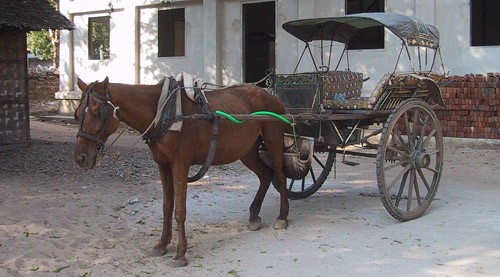 Burmese Ponies, also known as Shan Ponies, originated in the
Shan state of Eastern Burma, where they are bred today by local tribes. They
are similar to Bhutia, Spiti, and Manipuri ponies of the Himalayan Mountains,
suggesting these breeds have a similar origin, most likely deriving from the
Mongolian horse and other Eastern breeds.
Burmese Ponies, also known as Shan Ponies, originated in the
Shan state of Eastern Burma, where they are bred today by local tribes. They
are similar to Bhutia, Spiti, and Manipuri ponies of the Himalayan Mountains,
suggesting these breeds have a similar origin, most likely deriving from the
Mongolian horse and other Eastern breeds.
Burmese ponies may reach 13 hands high, and are brown, bay,
chestnut, black or gray in color. They are not particularly pretty horses,
having been bred for function rather than looks. The head usually has a
straight profile, the neck is muscular. The back may be long, and the croup is
sloping. The ponies do not have very pronounced withers, and a rather upright
shoulder, creating a short str
...
|
 |
|
 Buryats Buryats
|
|
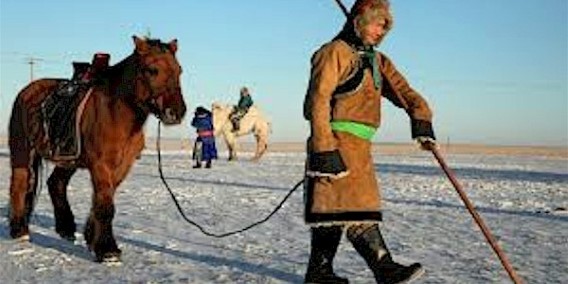 Buryats are one of the smallest horses in Siberia and share
ancestors with the Mongolian breed, although they tend to be taller. They are native
to a climate that is incredibly harsh, (there are only about a 100 days a year
above freezing temperatures in parts); and as a result they are very tough.
Buryats are one of the smallest horses in Siberia and share
ancestors with the Mongolian breed, although they tend to be taller. They are native
to a climate that is incredibly harsh, (there are only about a 100 days a year
above freezing temperatures in parts); and as a result they are very tough.
Throughout the years severe (and often cruel) training
methods combined with selective breeding and an intense natural environment has
created an almost indestructible, fertile animal with a long life span.
Since 1897 Thoroughbred stallions (and some trotters) have
been brought to the area to improve the breed. However the fertility and
toughness of the breed tends to be compromised by the influx of new bloo
...
|
 |
|
 Busak Posavec Busak Posavec
|
|
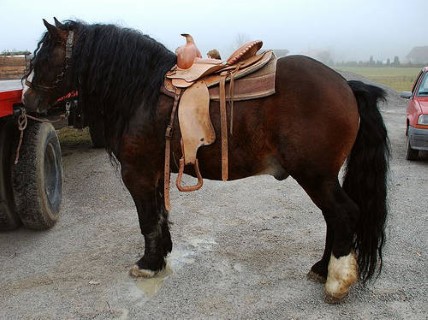 Busak posavec (also known as Croation Pasavac, Posavina,
Hrvatski Posavic , and Busak Posavec) horses comes from the flood plains of the
Sava River in Croatia. Currently their numbers are very low.
Busak posavec (also known as Croation Pasavac, Posavina,
Hrvatski Posavic , and Busak Posavec) horses comes from the flood plains of the
Sava River in Croatia. Currently their numbers are very low.
On average they are around 15.2 hands high. Their head is
noble and broad. Their ears are concave and elliptic. Their hooves are broad
and flat. They are found in black, grey, and bay.
They are bred for light agriculture work and vegetation
management.
|
 |
|
 Byelorussian Harness Byelorussian Harness
|
|
 Byelorussian Harness horses were developed Dole, Ardennes,
and Brabancon horse breeds. The Dole influence was the strongest. Long-term
inter breeding of various generations of crosses created a breed that is
very suitable for work in wooded areas with swampy and sandy soils.
Byelorussian Harness horses were developed Dole, Ardennes,
and Brabancon horse breeds. The Dole influence was the strongest. Long-term
inter breeding of various generations of crosses created a breed that is
very suitable for work in wooded areas with swampy and sandy soils.
They are a medium-sized horse with the characteristic
conformation of a harness horse. Their head is not large, their forehead is
wide, their neck is well muscled and average in length, their withers are
average in height and length, their back long, flat and often slightly dipped,
their loin is flat and short, their croup is wide, nicely rounded and well
muscled with a normal slope, their chest wide and deep. Their limbs are clean
and solid. T
...
|
 |

